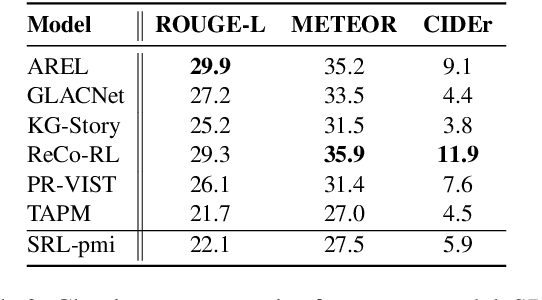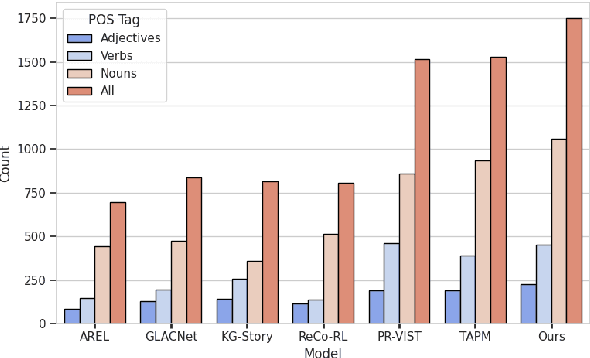Eileen Wang
GEM-VPC: A dual Graph-Enhanced Multimodal integration for Video Paragraph Captioning
Oct 12, 2024Abstract:Video Paragraph Captioning (VPC) aims to generate paragraph captions that summarises key events within a video. Despite recent advancements, challenges persist, notably in effectively utilising multimodal signals inherent in videos and addressing the long-tail distribution of words. The paper introduces a novel multimodal integrated caption generation framework for VPC that leverages information from various modalities and external knowledge bases. Our framework constructs two graphs: a 'video-specific' temporal graph capturing major events and interactions between multimodal information and commonsense knowledge, and a 'theme graph' representing correlations between words of a specific theme. These graphs serve as input for a transformer network with a shared encoder-decoder architecture. We also introduce a node selection module to enhance decoding efficiency by selecting the most relevant nodes from the graphs. Our results demonstrate superior performance across benchmark datasets.
SCO-VIST: Social Interaction Commonsense Knowledge-based Visual Storytelling
Feb 01, 2024



Abstract:Visual storytelling aims to automatically generate a coherent story based on a given image sequence. Unlike tasks like image captioning, visual stories should contain factual descriptions, worldviews, and human social commonsense to put disjointed elements together to form a coherent and engaging human-writeable story. However, most models mainly focus on applying factual information and using taxonomic/lexical external knowledge when attempting to create stories. This paper introduces SCO-VIST, a framework representing the image sequence as a graph with objects and relations that includes human action motivation and its social interaction commonsense knowledge. SCO-VIST then takes this graph representing plot points and creates bridges between plot points with semantic and occurrence-based edge weights. This weighted story graph produces the storyline in a sequence of events using Floyd-Warshall's algorithm. Our proposed framework produces stories superior across multiple metrics in terms of visual grounding, coherence, diversity, and humanness, per both automatic and human evaluations.
RoViST:Learning Robust Metrics for Visual Storytelling
May 08, 2022



Abstract:Visual storytelling (VST) is the task of generating a story paragraph that describes a given image sequence. Most existing storytelling approaches have evaluated their models using traditional natural language generation metrics like BLEU or CIDEr. However, such metrics based on n-gram matching tend to have poor correlation with human evaluation scores and do not explicitly consider other criteria necessary for storytelling such as sentence structure or topic coherence. Moreover, a single score is not enough to assess a story as it does not inform us about what specific errors were made by the model. In this paper, we propose 3 evaluation metrics sets that analyses which aspects we would look for in a good story: 1) visual grounding, 2) coherence, and 3) non-redundancy. We measure the reliability of our metric sets by analysing its correlation with human judgement scores on a sample of machine stories obtained from 4 state-of-the-arts models trained on the Visual Storytelling Dataset (VIST). Our metric sets outperforms other metrics on human correlation, and could be served as a learning based evaluation metric set that is complementary to existing rule-based metrics.
 Add to Chrome
Add to Chrome Add to Firefox
Add to Firefox Add to Edge
Add to Edge